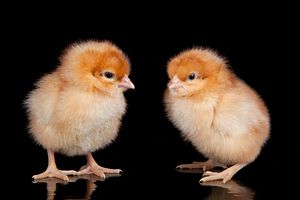In an amusing and widely circulated story, it has emerged that a school district in Uzbekistan is paying its teachers in freshly hatched chicks, due to a lack of cash. The teachers, in the city of Nukus, in the Karakalpakstan autonomous republic, are not too happy with this decision as they were not paid in cash last year either, as one told Radio Ozodlik.
“Last year they paid us with potatoes, carrots and pumpkins. This year they are forcing us to take newborn chickens instead of our wages. If we need chickens we can buy them from a market at a much cheaper rate.”
While authorities believe that the chicks are worth 7000 soms ($2.50) for salary purposes, locals estimate that the going rate for chickens is half of that in local markets. Thus, if they were to sell their chickens for income, they would get half the money theoretically owed to them. While a commentator on Radio Ozodlik joked that the teachers could eat chicken three times a day, that would hardly be optimal, as it would not make sense to destroy one’s source of wealth.
While using food as payment may seem strange and impractical in a modern economy, it has a long history. Food–especially livestock–has been used as currency throughout much of the world, especially in parts of Asia without the presence of a strong or efficient state. When similar conditions prevail in the modern world, as in the case of this city in Uzbekistan, it is not surprising that people revert to using food as currency.
There are several advantages to using food as currency. It is common and a constant presence–being necessary for life–and being organic, it is usually self perpetuating. While fruits and vegetables rot, grain can last for a long time. Furthermore, several animals also produce renewable side products that can constantly be sold or exchanged for wealth or consumed without destroying the animal itself: cows and milk, sheep and wool, chicken and eggs. Various cattle-herding tribes subsist on the blood and milk of their livestock more often than not, only slaughtering the animals for food on special occasions. This, in and of itself, adds value and prestige to commodities used as food. This is almost like investing your money in a bank or the stock market and gaining a return through interest and dividends without really doing much!
Food products have been a source of wealth in Asia since the most ancient of times. In the ancient Middle East, spices, still relatively rare as trade with India and Southeast Asia was just beginning, were used as currency. For more mundane purposes, laborers were often paid daily in beer. Livestock has always been used as a source of wealth in Central Asia among Turkic and Mongol nomads. But it was also a major source of currency and wealth in ancient India as well, even after agriculture became predominant. During the Vedic era, around 1000 BCE, pastoralism was still dominant, and cattle were a key indicator of wealth and prosperity. Later on, as India became an agrarian society, cattle were still more valuable as producers of milk and plow animals. This was a major contributing factor to the taboo against slaughtering cows in Hinduism, as doing so would literally be the equivalent of destroying money.
The use of food as currency also has a long history in East Asia. In Tokugawa Japan, the wealth of the daimyo (feudal lords) was assessed in terms of how many rice koku–approximately 278 liters, the amount of rice said to be needed to sustain a person for a year–their domains produced. One particularly interesting use of organic matter as currency was the use of tea bricks in Tibet, parts of Mongolia, and Siberia. These bricks were not produced locally but were imported from China and could not self-perpetuate locally. Good tea was usually consumed while older tea or bad quality leaves remained in circulation as bricks.
Of course, using food as currency is not ideal. It can be better used as … well, food. However, when paid in chickens or other animals or crops, there’s much one can make out of such a situation, if the wealth is managed properly. There is a long history of this in Asia, especially Central Asia, with its tradition of enormous quantities of livestock being used as wealth in trade with people with cash.

































